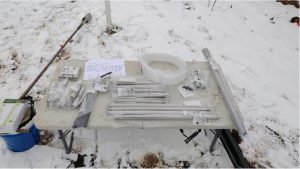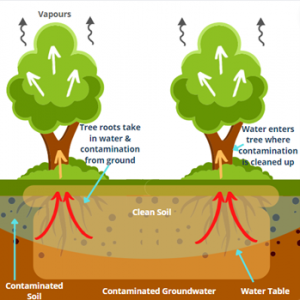 More than 40 years ago, a former industrial site in the City of Guelph, Ontario, was contaminated by toluene – a colourless, water-insoluble liquid often associated with paint thinners. The chemical plume has since leached into the underlying fractured bedrock aquifer. Today, the site is home to a unique research project that involves planting trees and tracking contaminant concentrations in groundwater using Solinst Model 615 Multilevel Drive-Point Piezometers.
More than 40 years ago, a former industrial site in the City of Guelph, Ontario, was contaminated by toluene – a colourless, water-insoluble liquid often associated with paint thinners. The chemical plume has since leached into the underlying fractured bedrock aquifer. Today, the site is home to a unique research project that involves planting trees and tracking contaminant concentrations in groundwater using Solinst Model 615 Multilevel Drive-Point Piezometers.
Being headed by the University of Guelph Morwick G360 Groundwater Research Institute, the research project first tested whether the planting of 51 hybrid poplar trees would speed up the toluene clean-up efforts. The poplar trees tested the process of phytoextraction where trees take up the contamination by pulling it through their roots and out into the atmosphere. Toluene was measured through samples of sap taken from the trees.

Meanwhile, the contaminant concentrations in the groundwater were measured and sampled at several depths using two Solinst Model 615 Multilevel Drive-Point Piezometers which were installed in multilevel wells (measuring several discrete groundwater zones within an area) to monitor the plant-assisted toluene attenuation process. Vapour sampling also took place using monitoring ports in the vadose zone.
Encouragingly, the study has shown that the tree plantings have enhanced the bioremediation occurring in the groundwater and vadose zone.
While the poplar trees have now been removed, they have been replaced by 120 willow trees, and research into phytoremediation (the clean-up of contaminants using plants) continues at the site.
 The institute hopes that the research will demonstrate how phytoremediation alongside more aggressive remediation tactics can be used to improve the clean-up outcomes at toluene contaminated sites.
The institute hopes that the research will demonstrate how phytoremediation alongside more aggressive remediation tactics can be used to improve the clean-up outcomes at toluene contaminated sites.
The Solinst Model 615ML Multilevel Drive-Point Piezometer is available through Hydroterra and you can read more about this project here.






